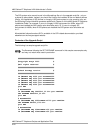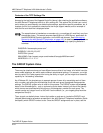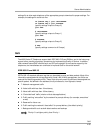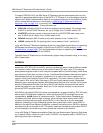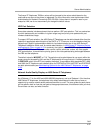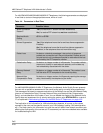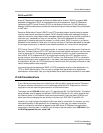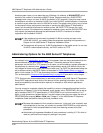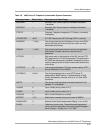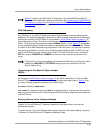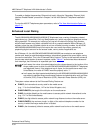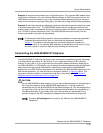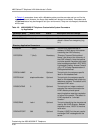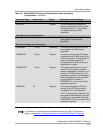
4600 Series IP Telephone LAN Administrator’s Guide
Administering Options for the 4600 Series IP Telephones
4-30
Another system value you can administer as of Release 1.8 software, is NVVLANTEST, which
stands for the number of seconds the 4600 IP Series Telephone waits for a DHCPOFFER
message when using a non-zero VLAN ID (the default is “60” seconds). Using this value insures
the telephone can return to the default VLAN if an invalid VLAN ID is administered or if the phone
is moved to a port where the value in L2QVLAN is invalid. The default value is fairly long, to allow
for the scenario that a major power interruption is causing the 4600 Series IP Telephones to
restart, but time should be allowed for network routers, the DHCP/TFTP Servers, etc. to be
returned to service. If the telephone is restarted for whatever reason and the NVVLANTEST time
limit expires, the telephone assumes the administered VLAN ID is invalid and re-initiates
registration with the default VLAN ID.
Administering Options for the 4600 Series IP Telephones 4
As indicated in the Introduction, on page 4-1
of this chapter, there are many parameters that can
be administered for the 4600 Series IP Telephones. This section explains how to change
parameters via the DHCP or TFTP servers. In all cases, you will be setting a system parameter in
the telephone to a desired value. Table 4-5
lists the parameter names, their default values, the
valid ranges for those values, and a description of each one. For DHCP, the parameters below are
set to desired values in the DHCP Option, as discussed in DHCP Generic Setup, on page 4-7
earlier in this chapter. For TFTP, the parameters below are set to desired values in the TFTP Script
File, as discussed in Contents of the Upgrade Script, on page 4-22
also earlier in this chapter.
TFTP Scripts are the recommended way to administer options on the 4600 Series IP Telephones.
Some DHCP applications have limits on the amount of user-specified information; such limits
could be exceeded by the administration required, for example, a 4630 with all applications
administered.
You may choose to completely disable the capability to enter or change option settings from the
dialpad, as of Release 1.8. As of that Release, a new system value, PROCPSWD, can be set as
part of standard DHCP/TFTP administration. If PROCPSWD is non-null and consists of 1 to 7
digits, no local procedures (“dialpad options”) can be invoked unless the user enters the value of
PROCPSWD after pressing Mute or Hold (see “Chapter 3" of the 4600 Series IP Telephone
Installation Guide) and before entering the local procedure code.
■ If the telephone has returned to the default VLAN but must be put back on the
L2QVLAN VLAN ID, you need to Reset the telephone according to the procedure in
Chapter 3 of the 4600 Series IP Telephone Installation Guide.
■ The telephone will ignore any VLAN ID administered on the media server if a non-zero
VLAN ID is administered manually, via DHCP, and/or via TFTP.
■ Because this password is likely stored on the server “in the clear” and is certainly sent
to the telephone in the clear, you should not consider PROCPSWD as a high-security
technique to inhibit a sophisticated end-user from obtaining access to the local
procedures.
■ Administering this password disables all local procedures, including V I E W, which is
read-only and would not change any settings in any case.



